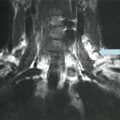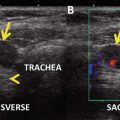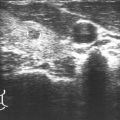Fig. 14.1
Overall survival is significantly better in patients demonstrating a biochemical incomplete response to therapy than patients demonstrating a structural incomplete response to therapy (Kaplan–Meier analysis, p < 0.0001) (Adapted from Ref. [16] with permission)
Furthermore, studies have shown that serum Tg levels can spontaneously decrease and become undetectable over years of time in both patients treated [17] or not treated with radioactive iodine after surgical treatment [18]. In the two cited studies [17, 18], with a median of 5–10 years of follow-up, serum Tg levels became undetectable in up to 72–79 % of the patients at the end of follow-up, especially in those who had low serum Tg levels at the beginning.
Lymph Node Involvement
The patient that was presented had small- volume lymph node involvement. Several studies have shown that the presence of lymph node metastases is associated with higher recurrence rates [19, 20], but its role in disease-specific survival is very small, except in older patients with follicular thyroid cancer [20]. However, research has also shown that there are pathologic factors that should be evaluated related to lymph node metastases that may differ from patient to patient: for example, size, number, locations in the neck, and the presence of extranodal extension are some of the important pathologic variables that should be analyzed in a patient with lymph node metastasis. The ATA Taskforce on Thyroid Cancer Nodal Surgery concluded that metastatic lymph nodes that are small, fewer than five in number, incidentally found (i.e., clinically N0, and with no extranodal extension have a very low impact on prognosis [21]).
Radioiodine Remnant Ablation
In the presented case, we have a young patient with a very low risk of mortality [T3, N1a, M0, less than 45 years old (AJCC stage 1)] and a low to intermediate risk of recurrence. For such patients, the low-dose approach for remnant ablation has been recently validated. In two randomized controlled trials, it was demonstrated that radioiodine ablation could be performed using 30 mCi with recombinant human TSH preparation [22, 23]. Some authors have also shown that these patients might even be followed without radioiodine ablation, especially if their postoperative stimulated Tg is less than 1 ng/ml [24] or even if the unstimulated Tg is <1 ng/ml [25].
In patients with stable or declining serum Tg values during follow-up, an empirical dose of radioiodine was shown to have no benefit [26]. This approach should be restricted to carefully selected patients with documented progression of serum Tg [26]. The selected group that might benefit from empirical treatment is high-risk patients with increasing serum Tg levels that had radioiodine-sensitive disease to begin with and in whom it was not possible to find the source of Tg production in cross-sectional imaging [13].
TSH Suppression
TSH suppression is usually defined as a serum TSH level below the lower limit of the reference range. It can be “full” (serum TSH <0.1 mU/L) or “partial” (serum TSH between 0.1 and 0.5 mU/L).
Most clinical practice guidelines [12] recommend that low-risk patients, especially those with an excellent response to initial therapy, do not need TSH suppression. In contrast, TSH suppression, either full or partial, is thought to be beneficial in the incomplete response group (both biochemical and structural incomplete) but always taking into account the patient’s clinical status. In young patients like the one presented here, this strategy seems to be appropriate.
Case Management
The patient under discussion is a young woman with an incomplete biochemical response to therapy (surgery and radioiodine therapy), with intermediate risk of recurrence tumor and a very low risk of death from thyroid cancer based on the current stratification systems mentioned above. After initial therapy she has an elevated but stable serum Tg, with no evidence of structural disease. Based on the data presented above, this patient should be followed only with surveillance at this point. As suppressed Tg is already elevated, it should be used to follow this patient’s trend, and Tg stimulation is not necessary. Neck ultrasound should be ordered, at least annually, in the first five years and after that it would depend on the suppressed serum Tg trend.
Clinical Pearls/Pitfalls
Risk assessment for recurrent PTC should include not only the initial pathological findings and patient age but also a more dynamic assessment that includes the response to initial therapy.
An isolated elevated serum Tg should not be treated with empiric radioiodine therapy since, in the absence of identifiable structural disease, the overall survival is very high and structural recurrence seems to be low.
A great number of low- to intermediate-risk patients will have a spontaneous decrease in serum Tg levels with no additional therapy.
References
1.
Hundahl SA, Fleming ID, Fremgen AM, et al. A national cancer data base report on 53,856 cases of thyroid cancer treated in the US 1985–1995. Cancer. 1998;83:2638–848.PubMed
2.
McLeod DS, Sawka AM, Cooper DS. Controversies in primary treatment of low-risk papillary thyroid cancer. Lancet. 2013;381(9871):1046–57.CrossRefPubMed
Stay updated, free articles. Join our Telegram channel

Full access? Get Clinical Tree






